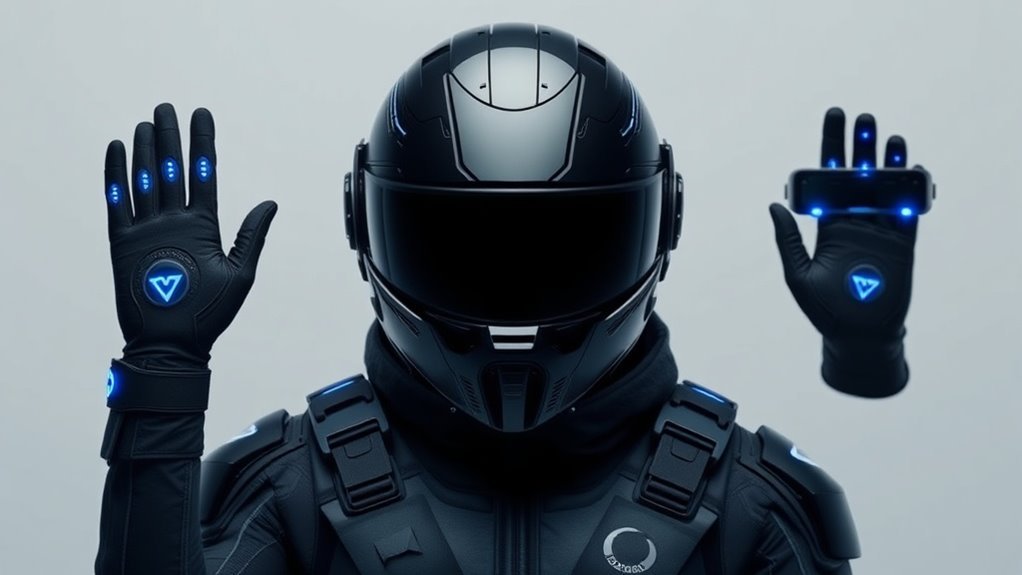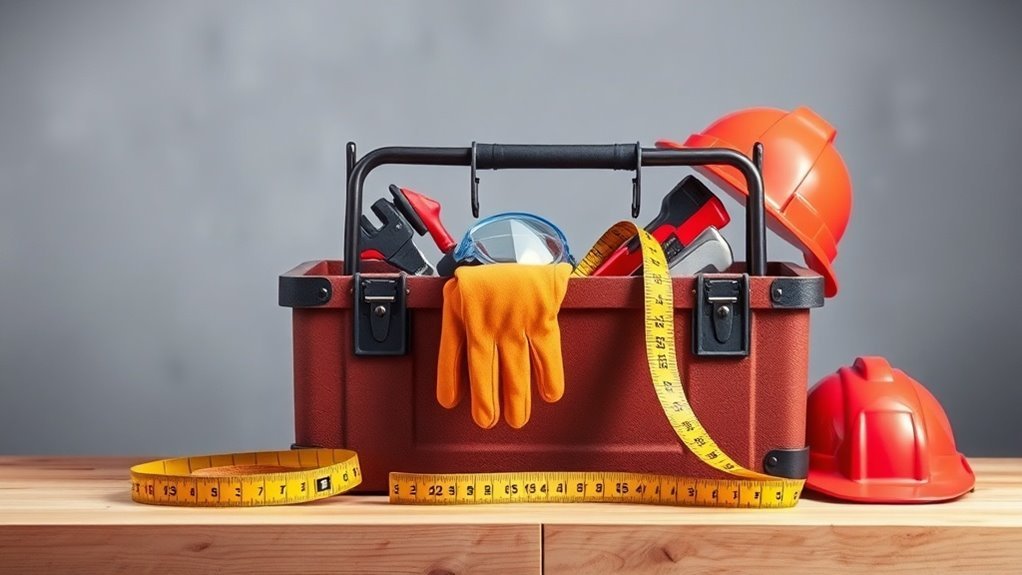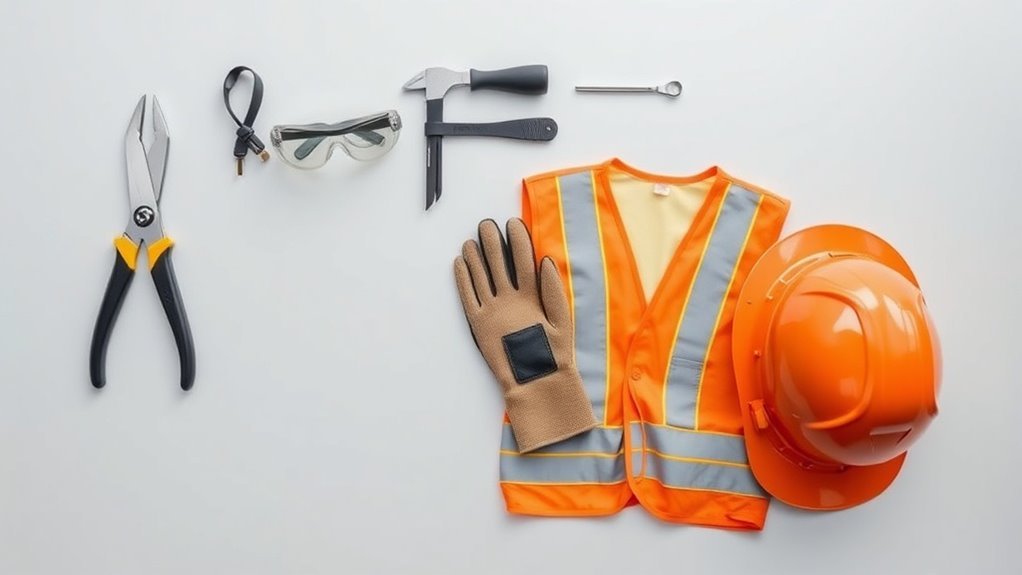Importance of Respiratory Protection in DIY Work
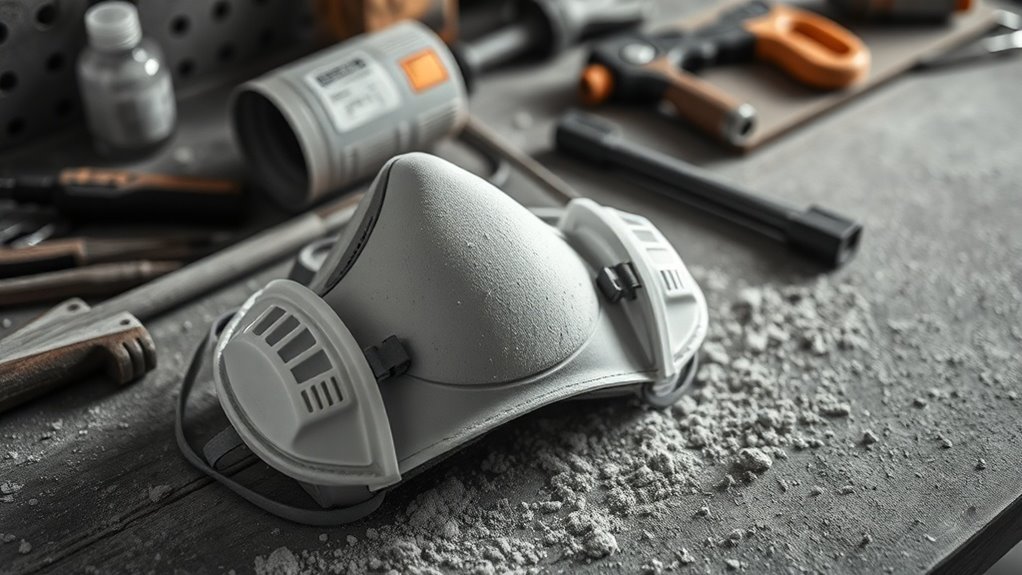
When you’re doing DIY projects, respiratory protection is vital. Activities like sanding, painting, or using adhesives can release harmful dust and fumes that can damage your lungs over time. Wearing the right mask guarantees you’re protected from these hazards, whether it’s a simple dust mask or a full-face respirator. Neglecting this aspect can lead to serious health risks. Discovering how to choose and maintain your protective gear can further enhance your safety during these projects.
Key Takeaways
- Respiratory hazards from dust, fumes, and vapors are common in DIY projects, posing risks to lung health.
- Proper respiratory protection helps prevent irritation and long-term health issues associated with exposure to harmful substances.
- Different DIY tasks require specific masks; choosing the right type increases safety and effectiveness in protecting against various hazards.
- A well-ventilated workspace supplemented by adequate respiratory protection enhances safety and reduces airborne contaminant levels.
- Regular maintenance and usage training for respiratory equipment ensure optimal protection and longevity in DIY activities.
Understanding Respiratory Hazards in DIY Projects
When you tackle DIY projects, it’s easy to overlook the potential respiratory hazards lurking in common materials. Whether you’re sanding, painting, or cutting, you mightn’t realize how dust, fumes, and vapors can affect your health.
For instance, wood dust from cutting or sanding can lead to respiratory irritation or even long-term issues. Similarly, paint and solvents often release volatile organic compounds (VOCs) that can impair your lungs’ function.
Even household products like adhesives and cleaning agents can emit harmful particles. It’s essential to be aware of these risks, as prolonged exposure can lead to significant health problems.
Taking the time to understand these hazards will help you make informed decisions about your safety while working on your next project.
Types of Respiratory Protective Equipment
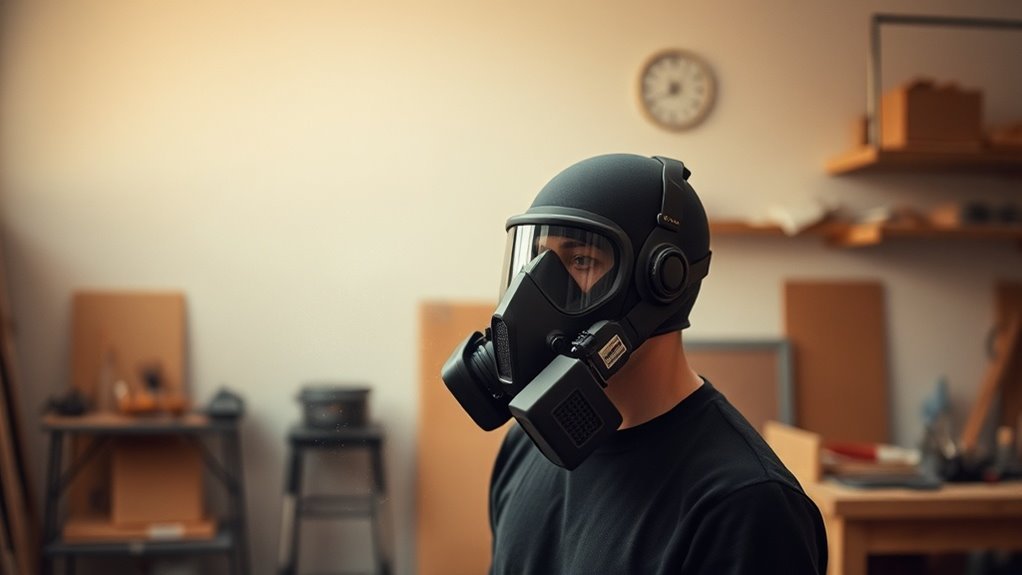
Understanding the respiratory hazards in DIY projects highlights the need for proper protection while working with materials that can affect your health.
There are several types of respiratory protective equipment to take into account. Disposable masks, like N95 respirators, filter out particulates and are great for short tasks. Half masks come with replaceable filters and provide a snug fit, ideal for prolonged use.
Full-face respirators offer maximum protection against both particulates and harmful vapors while ensuring visibility. Powered air-purifying respirators (PAPRs) use a battery-operated blower to circulate filtered air, providing comfort during long jobs.
Selecting the right type of respiratory protection is essential to ensuring your safety, so familiarize yourself with these options before starting your DIY project.
Choosing the Right Mask for Your Project
When picking the right mask for your project, you need to evaluate the different types available and how they fit. A proper fit is essential because it guarantees maximum protection from harmful particles.
Let’s explore what options work best for your specific needs.
Mask Types Overview
Choosing the right mask for your project can make all the difference in ensuring your respiratory safety. There are various types of masks tailored to different tasks, and knowing which one suits your needs is essential. Here’s a quick overview of common mask types:
| Mask Type | Protection Level | Best For |
|---|---|---|
| Dust Mask | Low | Light dust and particles |
| Respirator (N95) | Moderate | Fine particles and aerosols |
| Powered Air Purifying Respirator (PAPR) | High | Chemical vapors and extended use |
| Full-Face Respirator | Very High | Hazardous materials, extensive exposure |
Proper Fit Importance
A proper fit is essential for any respiratory mask you select, as even the best mask can fail to protect if it doesn’t seal correctly to your face.
When choosing a mask, make sure it covers both your mouth and nose snugly without gaps. You should try on different sizes and styles; what works for someone else mightn’t work for you. Consider adjustable straps to enhance the fit.
Don’t forget to check for compatibility with other PPE, like safety goggles. Remember, a good fit increases your mask’s effectiveness against dust, fumes, and chemicals.
Regularly inspect the mask for signs of wear or damage, as a compromised fit can greatly reduce protection. Prioritize fitting to safeguard your health during DIY projects.
Properly Fitting Your Respirator
Finding the right fit for your respirator is essential for guaranteeing effective protection. When you wear a mask that doesn’t fit properly, you might expose yourself to harmful particles.
Start by selecting the correct size based on the manufacturer’s guidelines. After that, perform a fit test. Place the respirator on your face and adjust the straps so it sits snugly. Make sure there’s no gap between your face and the respirator edges.
To check the seal, inhale sharply; if you feel a pull inward, it’s sealed correctly. Remember to check the fit each time you wear it, as facial changes or different hairstyles could affect it.
Proper fit not only enhances protection, but it also guarantees comfort during your DIY tasks.
Common Misconceptions About Respiratory Protection
When it comes to respiratory protection, you might think masks are optional or only necessary for dealing with harmful materials.
There’s also a common belief that one size fits all when it comes to respirators.
Let’s clear up these misconceptions and understand why proper protection is critical for everyone.
Masks Are Optional
Many people still believe that masks are optional and don’t see the need for respiratory protection in certain situations. This misconception can be risky, especially during DIY projects that generate dust, fumes, or other airborne particles.
You might think that wearing a mask is overkill, but it’s vital to protect your lungs from harmful substances. Even common materials, like wood or paint, can release irritants.
By choosing to wear a mask, you’re prioritizing your health and safety. Remember, just because you can’t see harmful particles doesn’t mean they’re not there. It’s better to be safe than sorry.
Only Harmful Materials
It’s a common misconception that respiratory protection is only necessary when working with obviously harmful materials, like toxic chemicals or hazardous dust.
In reality, everyday DIY tasks can produce unseen particles that could harm your lungs. For example, sanding wood can release fine dust, while using certain paints or adhesives may emit harmful fumes.
Even non-toxic materials can irritate your respiratory system over time. You might think you’re safe because you’re not handling dangerous substances, but airborne particles can still pose a risk.
It’s crucial to recognize that respiratory protection isn’t just for extreme situations; it’s essential for various tasks.
One Size Fits All
Assuming that one type of respiratory protection fits all scenarios is another common misconception.
Different tasks expose you to varying types of airborne hazards, from dust and fumes to vapors and pathogens. What works for one DIY project mightn’t safeguard you during another.
For instance, a simple dust mask might suffice while sanding wood, but it won’t offer adequate protection when using chemical solvents.
You need to assess the specific risks associated with each task and select an appropriate respirator.
Understanding the right fit and filter type can make a significant difference in your safety.
Don’t compromise; make certain you’re using the right gear for the specific job to guarantee your health isn’t at risk.
Short-term vs. Long-term Risks of Inhalation
While the immediate effects of inhaling harmful substances can be alarming, understanding the differences between short-term and long-term risks is essential for effective respiratory protection.
Short-term risks often include irritation, headaches, and dizziness. These symptoms can be uncomfortable but may resolve quickly once exposure stops.
On the other hand, long-term risks can have more serious implications for your health, leading to chronic respiratory conditions or even cancer. Prolonged exposure to harmful particles can damage your lungs and affect your overall wellness irrevocably.
By recognizing these differences, you can better appreciate the importance of wearing proper respiratory protection during your DIY projects.
Prioritizing your health now can prevent significant issues down the road. Remember, it’s not just about the moment; it’s about your future.
Best Practices for Maintaining Respiratory Safety
Maintaining respiratory safety is essential, and there are several best practices you can implement to protect your lungs effectively.
Always wear a proper mask rated for the specific hazards you’re facing, like dust, fumes, or vapors. Make certain your workspace is well-ventilated, opening windows or using exhaust fans to reduce airborne contaminants.
Regularly check and maintain your respiratory equipment; replace filters as needed to guarantee peak performance. Keep your work area organized and clean to minimize dust buildup, and store hazardous materials correctly to prevent accidental exposure.
Finally, take frequent breaks in fresh air to give your lungs a chance to recover. Following these practices can greatly reduce your risk of respiratory issues while working on DIY projects.
Questions
Can I Use a Regular Face Mask Instead of a Respirator?
You can’t rely on a regular face mask instead of a respirator for protection against harmful particles. In many situations, a respirator provides the filtration needed to keep you safe during certain tasks.
How Often Should I Replace My Respirator Filters?
Think of your respirator filters like a sponge—over time, they’ll soak up pollutants and lose effectiveness. You should replace them every 30 to 60 days, or sooner if they look dirty or feel restricted.
Are There Specific Respirators for Woodworking Projects?
Yes, there are specific respirators designed for woodworking projects. You’ll want a mask with a P100 filter or similar, as they effectively capture fine dust particles and protect you from harmful wood dust exposure.
What Should I Do if I Feel Dizzy While Using a Respirator?
If you feel dizzy while using a respirator, stop working immediately, remove the respirator, and take deep breaths in fresh air. If dizziness persists, seek medical attention to guarantee your safety.
Can Respiratory Protection Be Used for Paint Fumes?
Think of a castle’s drawbridge keeping out the invading fumes. Your respirator acts just like that, guarding you against harmful paint fumes while you create your masterpiece. So, wear it and breathe easy!
Conclusion
In the whirlwind of your DIY projects, don’t underestimate the power of respiratory protection. Ignoring it isn’t just risky—it’s like inviting an army of toxic fumes to invade your lungs! By choosing the right mask and ensuring it fits snugly, you’re not just protecting yourself; you’re becoming a superhero against harmful particles. So, gear up, breathe easy, and release your creativity without sacrificing your health. Remember, your lungs deserve a safe workspace just as much as your masterpiece does!

